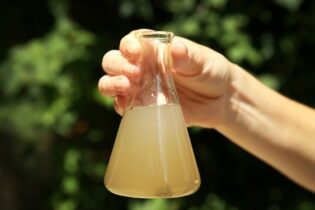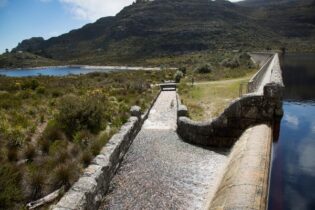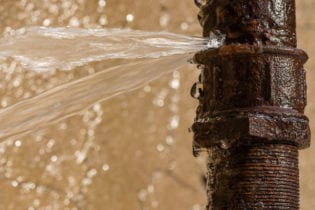A realistic perspective of energy optimisation considerations: Part II
Objective of study
Rudi Scheepers*, Marlene vd Merwe-Botha**
*Arcus GIBB (Pty) Ltd, P.O. Box 3965, Cape Town, 8000, South Africa.
Email: rscheepers@gibb.co.za
**WaterGroup (Pty) Ltd, South Africa
This study seeks to contextualise and illustrate current application and trends in the South African municipal wastewater industry as pertaining to treatment technologies, plant capacity, electricity consumption trends and good practices applied in electricity supply and demand management. The paper also intends to raise discussion and awareness among the sector players regarding the respective roles in:
- viewing and planning for WWTPs as energy producers and cost conservers as opposed to a facility to ‘treat sewage’ without any further benefit
- initiate opportunities to have the first full-scale self-sufficient WWTP in Africa in the near future
- municipal wastewater practitioners, process controllers and scientists are scarce professions and critical enablers in realising any opportunity associated with energy optimisation, cost recovery and sustainable management and compliance.
METHODOLOGY The methodology followed in the study is presented via specific subject areas as follows:
Situation analysis of existing technology types The Green Drop 2009 and 2011 assessments were used to evaluate the various technologies (treatment processes) applied by municipalities across the nine provinces in South Africa (DWA 2009, DWA 2011). A framework was developed to categorise the various technologies, consisting of 16 technology types. Further simplification of the technology types was done by reducing the various types into three generic groups: i) activated sludge processes and variations thereof ii) trickling biofilters iii) pond and lagoon systems. The approach was followed to use updated (2010/11) information where available, and only revert to 2009 information where data was lacking. Where a plant comprises of two or more technology types, each type would count for one technology. Only municipal plants with a verification track record were processed.
Trend analysis in technology applications A total of 18 plants was selected (DWA licensing database, 2010) to determine the best spread of plants across the nine provinces for technology trends assessment against the following assessment framework:
| Assessment criteria | Reference framework |
| Legislative requirements | Water use licence, general authorisation, previous exemptions (general/special standard) |
| Environmental landscape | Present ecological state and condition (PESC) |
| Technology levels employed (existing and new) | Low-, medium- and high-end technologies as available in market place |
| Municipal environment and technology impact. | CoGTA spatial analysis framework (municipal size, social-economic vulnerability, National Treasury (NT) classification, audit outcomes, and the extent to which the municipality is undertaking all of its possible local government functions (as a percentage)). |
The data results were processed to determine the movement in technology trends from recent/current processes employed to current/future processes planned or employed, in terms of the three broad technology types investigated. This study was conducted in cooperation with the Water Research Commission and SALGA (Bhagwan
et al., 2011).
Energy consumption per technology type and capacity The data in the Green Drop report (DWA 2011) was used to confirm the plant capacity and actual flow received at plants. These design capacities were used to determine the number of plants in micro, small, medium, large and macro size categories. The energy usage per unit process was derived from work done by the US’s Electric Power Research Institute (EPRI) energy audits (1994) and used to evaluate the energy consumption (kWh/d) on two levels:
- plant capacity (size) category
- activated sludge and biofilters technology groupings as per Table 1
The energy consumption (kWh) per volume was evaluated according to the treatment processes of the plant. Only medium size plants (2 to 10 Mℓ/d) to macro size plants where evaluated from published energy consumption data.
Energy as a running cost in municipalities Financial ring-fencing of water services provision is a legal requirement (Water Services Act of 1997) where it is stated that: “When performing the functions of a water services provider, a water services authority must manage and account for those functions separately” (Sect 20.(1)). The above, however, leads to two problem statements; which are:
- Definitive information as to the extent of ring fencing is not readily available, although the Green Drop initiative is focusing more attention on this compliance parameter. Energy is a real and comprehensive element of the cost of the wastewater treatment service and should be recovered via responsible tariff setting, offsetting, etc.
- Section 10 of same Act need to be complied with when formulating tariffs. This would require financial sustainability (adequate budget for O&M), recovery of cost reasonable associated with providing the service, the need for return on capital investment for the provision of the service, etc (Moshidiet al., 2011)
As a first step to ensure cost reflective recovery of services cost as part of municipal financial sustainability, it is necessary to establish broad comparative and costing comparisons as pertaining to different treatment technologies in the municipal sector. To present such first order material as part of this study, linkage is made to studies undertaken with the Department of Water Affairs’ Water Services Regulation in extracting actual figures from treatment plants that reported ring-fenced costs for the respective treatment plants during the 2011 Green Drop assessments. The baseline costing reported in Municipal Wastewater Treatment: First Order Costing Of Capital And Additional Operations And Maintenance Funding Requirements Based On Risk Based Indices (DWA, 2009) were used to expand and escalate on the cost configurations, which were based on actual tender prices in 2008 to provide for a 2011 baseline estimate.
Improved application: Energy efficiency Opportunities for improved efficiency are various, and an attempt was made to comment on practical ways of optimising energy efficiencies as applicable to the technology types under discussion, in the following context:
- Improved energy efficiency through demand side management: Integrate first order analysis data from the energy utilisation by typical types of WWTPs in the country.
- Improved energy efficiency through supply side management and energy generation: Projections of first order analysis to various energy generation potentials mainly to large (10 to 25 Mℓ/d) and macro WWTPs (>25 Mℓ/d).
The above questions are raised as part of a full length submission, which will be featuring over subsequent editions as part of a series. In the next edition are the results and discussions raised from the study. For more information regarding the paper, please contact chantelle@3smedia.co.za.






